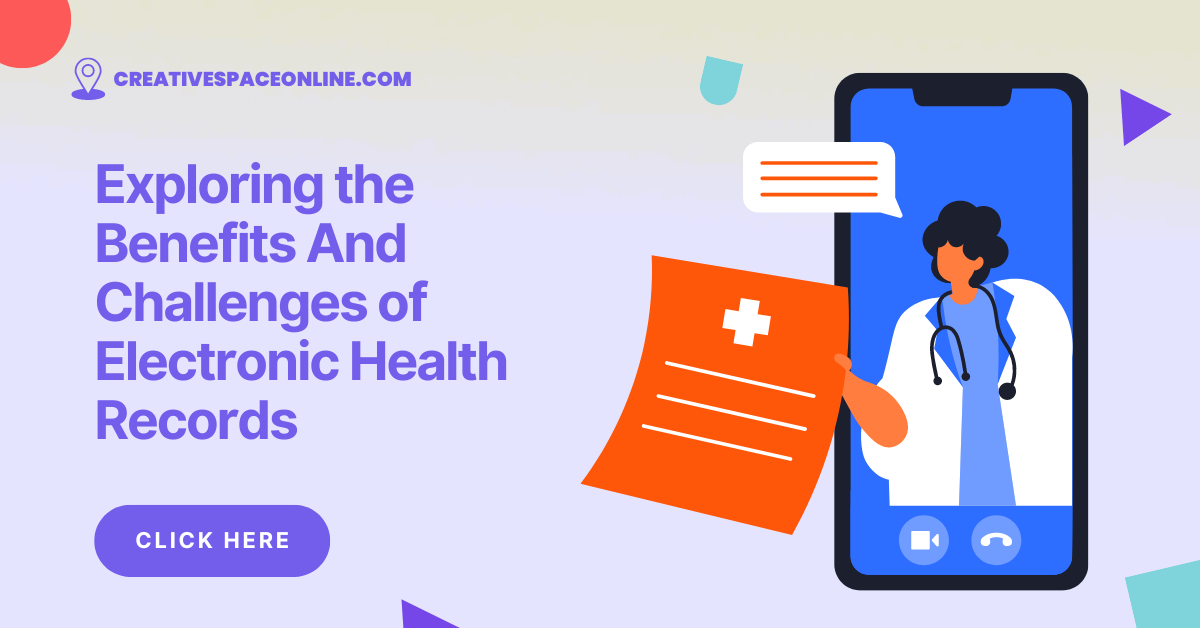Today’s fast-changing world of the medical sector has implemented one of the most significant changes in terms of how health information is stored. As the use of electronic health record expands across the world, healthcare workers, policymakers, and the general public must become acquainted with numerous opportunities as well as detached that accompany this innovative technology.
EHRs refer to electronic copies of a patient’s medical records from which details such as demographics, unified medical language system, problem diagnosis, and clinical treatments, among others, can be retrieved. EHRs provide an efficient paper replacement for healthcare professionals as they improve storage and patient documentation, and promote advanced information management.
According to a report by the Office of the National Coordinator for Health Information Technology (ONC), the adoption rate of basic EHR systems among non-federal acute care hospitals in the United States reached 96% in 2017, a significant increase from just 9.4% in 2008.
Benefits of Electronic Health Record
Imagine having your medical history readily available, anytime, anywhere. Electronic health record put you in the driver’s seat, allowing you to participate more actively in your healthcare decisions.
Improved Data Accessibility and Sharing
EHRs can also be valuable for sharing patient data between different physicians and other authorized care providers in any geographic location. This smooth flow of information allows the physicians to have relevant information about a patient which helps in decision making and care delivery.
For instance, Telehealth consultations can be facilitated by EHRs, enabling remote consultations and improved access to care, especially in underserved areas.
Enhanced Patient Care
By integrating patient health information in one place, EHRs allow doctors to get a comprehensive perspective of the patient’s health history. This broad approach not only helps to improve the diagnostic process and develop individual treatment regimens but also minimizes the chances of developing drug interactions and duplicative testing, thereby improving the quality of care provided.
EHRs can also be beneficial for cosmetic procedures, such as enhancing eyelash growth. Doctors can track a patient’s progress over time and tailor treatment plans accordingly.
Increased Efficiency and Reduced Administrative Costs
EHRs reduce the burden of transcription and data input, thus decreasing the chances of errors and also occupying less physical space than paper documents. A study conducted by the University of Michigan has revealed that the adoption of EHRs can result in a reduction of up to $3. 9 billion each year for outpatient practices in the United States.
Better Monitoring and Management of Population Health

EHRs can help large patient populations’ information to be collected and analyzed to identify health patterns, common risks, and other key points for intervention. It thus assists population health management programs, which in turn positively enhances the health of the population and the effective use of available resources.
Facilitated Clinical Research and Data Analysis
By making large volumes of anonymized patient data available to researchers, EHRs can greatly facilitate and advance clinical investigation. These databases hold a wealth of information that can provide new knowledge about the occurrence of diseases, the effectiveness of therapy, and the results of treatment to progress the field of medicine.
Supported Evidence-Based Decision-Making
EHRs are endowed with clinical decision support systems that enshrine the best practices, treatment plans, and preventive measures for health complications. This approach makes the delivered care quality high and ensures compliance with the existing guidelines.
Challenges of Electronic Health Record
While the benefits of EHRs are substantial, it is essential to acknowledge and address the challenges associated with their implementation and use.
High Implementation and Maintenance Costs
Numerous challenges arise in the implementation of an EHR system that can be highly costly for any healthcare organization such as the license fees for software and hardware, data conversion, and other maintenance charges. Source: American Hospital Association A study by the American Hospital Association has indicated that the average direct cost of an EHR system in a 500-bed hospital may be anywhere between $63 million and $124 million.
Data Privacy and Security Concerns
Since data contained in EHR is often sensitive patient information, issues of data privacy and security are crucial. The online threat is a major concern in the healthcare industry as it exposes the patient record database or personal identifying information to risks that might include hacking attempts and data breaches. There are severe restrictions on the sharing of patient data and a necessity for healthcare organizations to provide a secure environment and practice policies and protocols regarding the storage and use of patient information.
Potential for Technology-Related Errors and System Failures
Thus, challenges accompany every opportunity: the functioning of EHRs presages the skills of people and, at the same time, provides opportunities to make errors due to software problems, mistakes in the design of the interface, and so on. These challenges apply the pressure for thorough testing, regular updates or modifications, and user enlightenment to counter-check for the worst aspects that may be associated with the system.
Interoperability Issues among Different Electronic Health Record Systems
On the other hand, while EHRs promise to eliminate as many human mistakes as well as technological issues that may include software glitches a breakdown in the system, or suboptimal design, these aspects of the technology can also introduce new types of mistakes or data loss. These risks indicate that extensive testing and exercises, recurrent training, and maintenance to discharge the threats are crucial.
Resistance to Change and Adoption Challenges
Though the overall adoption of EHR is impressive, the issue of interoperability, where EHR systems from different organizations can both exchange data and interpret it in a meaningful way, remains a core challenge recognized in the healthcare field. Another key challenge is that of implementation, due primarily to high levels of variability in terms of data units and, related to this, the lack of clear data standards.
Need for Comprehensive Training and User-Friendliness
Adopting the paperless system in health care organizations is associated with the risks of facing opposition from health care practitioners who are used to the conventional ways of practicing their professions and may resist change intending for improvements. Pervasive Adoption Issues are indeed present but CMM can successfully address them through the implementation of robust Change Management Plans, extensive Training, and easy-to-navigate Interfaces.
Real-world Examples and Statistics
To illustrate the impact of EHRs, it is important to examine real-world examples and statistics that highlight their successful implementation and associated benefits.
Successful Electronic Health Record Implementation Cases
One such example is the use of the Veterans Health Information Systems and Technology Architecture (VistA) in the United States Department of Veterans Affairs (VA). This advanced EHR system has been praised for its efficiency in enhancing the delivery of care, the quality of care, and research. A study in the Journal of the American Medical Informatics Association has suggested that the VA’s EHR system has reduced hospital admissions by 25 percent and patient bed days by 19 percent.
Statistics on EHR Adoption and Improved Patient Outcomes
The ONC classified EHR adoption amongst office-based physicians in the U.S., from the year 2012 to a high of 86% in 2017 a statistic. Also, according to a cross-sectional study conducted by the Agency for Healthcare Research and Quality (AHRQ), the implementation of HIE with enhanced features such as a fully functional EHR system brought about a 16% reduction in adverse drug events and a 14% decline in medication dispensing mistakes.
Addressing Implementation Challenges
As discussed earlier, the gains that come with EHRs are apparent and acknowledged, but healthcare organizations have experienced hardships while deploying EHRs. According to the American Hospital Association survey on the initial impacts of EHR, about 60% of hospitals operating in the US claimed that their efficiency was cut by half due to disruptions in their workflow. Such challenges have been met head-on by firms by undertaking extensive training efforts, fine-tuning system layouts and structures, and adopting of effective change management plans.
Future Outlook and Recommendations

As the healthcare industry continues to embrace digital transformation, the future of EHRs holds immense potential for further advancements and integration with emerging technologies.
Emerging Trends and Advancements in Electronic Health Record Technology
Cloud-based EHR solutions, AI integration, and the Internet of Things are providing a path to better integration, data management, analytics, and associated supervisory functionalities. These advancements hold the promise of furthering clinical decision-making, patient interaction, and the development of innovative approaches to targeted medicine.
Strategies for Addressing Data Privacy and Security Concerns
Common threats such as data privacy breaches must be met with a good health information security system by incorporating features such as encryption access control and risk analysis from time to time. Furthermore, compliance with the rules and regulations such as the Health Insurance Portability and Accountability Act (HIPAA) for patient data in the United States or the General Data Protection Regulation (GDPR) for patients’ data for those countries that have signed this regulation is imperative.
Importance of User-Friendly Interfaces and Comprehensive Training
The audiences for this study are the following: industry stakeholders, design-conscious developers, and mobile health application aficionados For EHR systems to receive broad use and be implemented effectively across the nation, user interfaces and organizing design take precedence. Accommodation for heightened training is that healthcare organizations should invest in training programs geared towards promoting the use of EHR by preparing the professionals to handle the identified linkages from different user groups so that the full potential of EHR systems is harnessed.
Collaborative Efforts towards Standardization and Interoperability
Interoperability issues are major barriers that need to be solved through the combined efforts of EHR solution providers, providers, and governing organizations. Adopting universal data formats in HHS and integrating APIs will help streamline data exchange and promote effective transitions between different healthcare organizations.
Potential for Integration with Other Digital Health Technologies
EHRs are consequently predicated on the contextual environment of digital health, encompassing telemedicine, wearables, and RPM solutions. Through integrating EHR with these technologies, healthcare providers are in a position to gain an improved understanding of the patient’s state of health, to facilitate early intervention and patient-centered care plans.
For instance, through wireless technology, a patient’s wellness data such as temperature, activity, and sleep from wearable devices can feed into the patient’s EHR and alert doctors on potential health problems immediately. Likewise, telehealth applications can help with remote consultations, which means there is no need to see the patient in person to check their medical records and make a choice.
Conclusion
Electronic Health Records (EHRs) have become one of the cornerstones of modern healthcare systems due to the numerous opportunities they provide for effectively improving patient outcomes, improving the organization’s operations, and making data-informed decisions. As most scholars agree, EHRs have numerous benefits, including enhanced data access and information exchange, streamlined clinical research, and more effective implementation of evidence-based practices.
Nevertheless, the concerns of implementing and using EHRs, for instance, the high costs of implementing and using EHRs; data privacy and security, interoperability, and training and design of user interfaces cannot be ignored. Counteracting these challenges requires the organization’s active engagement and support for the collaborative processes aimed at the creation of unified standards and integration of EHR systems.
The continued expansion of the healthcare industry and increasing reliance on new technologies point to a bright future for EHRs. In this case, they found that digitization offers healthcare providers a way to provide more personal, integrated, and effective services to their patients.




